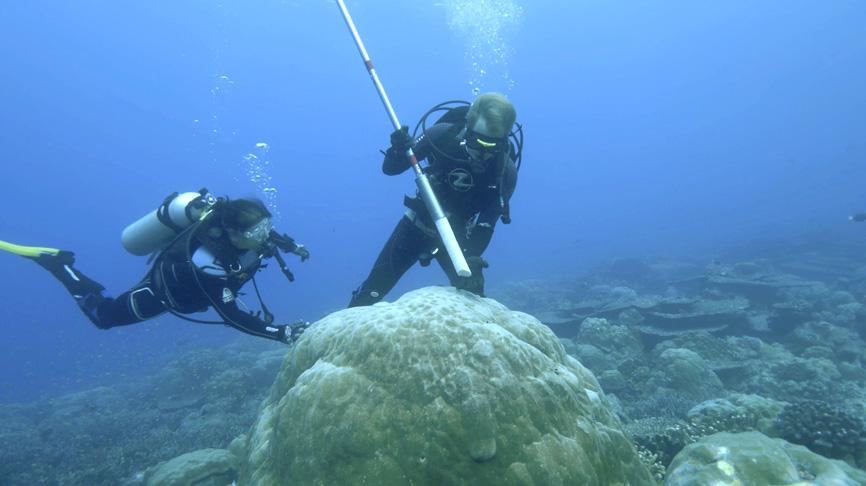The bushfires that swept through Australia last year were connected to a phenomenon known as the Indian Ocean dipole (IOD), which is expected to become more frequent due to climate change, a geologist studying coral fossils said yesterday.
National Taiwan University Department of Geosciences professor Shen Chuan-chou (沈川洲) since 2001 has been working with Australian and US researchers to study climate systems in the Indian Ocean.
Led by Australian National University Research School of Earth Sciences professor Nerilie Abram, the team published a paper on IOD in the journal Nature on March 9.

Photo courtesy of Nerilie Abram via CNA
The bushfires resulted from a positive IOD event, when the region east of the Indian Ocean becomes drier and there is a reduced chance of rainfall in Australia, Shen told an online news conference held at the Ministry of Science and Technology in Taipei.
To understand the change in climate over the past centuries, the team drilled the cores of live and fossil coral off Sumatra, Indonesia, as coral can be viewed as a thermometer of ocean temperature, Shen said.
Shen’s laboratory used radiometric uranium-thorium dating techniques to identify the ages of the coral samples.
The most important finding was that the climate systems in the Indian and Pacific oceans are “interconnected,” which previously had been a disputed hypothesis, he said.
While similar dating techniques used by other laboratories might have a margin of error of one to two years, Shen said that his laboratory had reduced the margin of error to as little as three months.
The team found that positive IOD events often occur in conjunction with El Nino in the central Pacific Ocean, he said.
Models show that strong IOD events have been increasing and they might become more extreme due to global warming, he added.
Nonetheless, an IOD event in 1675 was estimated to be 42 percent stronger than one documented in 1997, showing that such events are also possible without human-caused global warming, Shen said.
Referring to previous studies of El Nino, Shen said that climate oscillations in the Indian Ocean also affect the climate of Taiwan.
If the temperature in the central Pacific is rising, more typhoons form in the summer and more strike Taiwan in the fall, while rainfall in spring decreases, causing droughts in southern Taiwan, he said.
The government should formulate more policies to mitigate the effects of climate change, Shen said.

An essay competition jointly organized by a local writing society and a publisher affiliated with the Chinese Communist Party (CCP) might have contravened the Act Governing Relations Between the People of the Taiwan Area and the Mainland Area (臺灣地區與大陸地區人民關係條例), the Mainland Affairs Council (MAC) said on Thursday. “In this case, the partner organization is clearly an agency under the CCP’s Fujian Provincial Committee,” MAC Deputy Minister and spokesperson Liang Wen-chieh (梁文傑) said at a news briefing in Taipei. “It also involves bringing Taiwanese students to China with all-expenses-paid arrangements to attend award ceremonies and camps,” Liang said. Those two “characteristics” are typically sufficient

A magnitude 5.9 earthquake that struck about 33km off the coast of Hualien City was the "main shock" in a series of quakes in the area, with aftershocks expected over the next three days, the Central Weather Administration (CWA) said yesterday. Prior to the magnitude 5.9 quake shaking most of Taiwan at 6:53pm yesterday, six other earthquakes stronger than a magnitude of 4, starting with a magnitude 5.5 quake at 6:09pm, occurred in the area. CWA Seismological Center Director Wu Chien-fu (吳健富) confirmed that the quakes were all part of the same series and that the magnitude 5.5 temblor was

The brilliant blue waters, thick foliage and bucolic atmosphere on this seemingly idyllic archipelago deep in the Pacific Ocean belie the key role it now plays in a titanic geopolitical struggle. Palau is again on the front line as China, and the US and its allies prepare their forces in an intensifying contest for control over the Asia-Pacific region. The democratic nation of just 17,000 people hosts US-controlled airstrips and soon-to-be-completed radar installations that the US military describes as “critical” to monitoring vast swathes of water and airspace. It is also a key piece of the second island chain, a string of

The Central Weather Administration has issued a heat alert for southeastern Taiwan, warning of temperatures as high as 36°C today, while alerting some coastal areas of strong winds later in the day. Kaohsiung’s Neimen District (內門) and Pingtung County’s Neipu Township (內埔) are under an orange heat alert, which warns of temperatures as high as 36°C for three consecutive days, the CWA said, citing southwest winds. The heat would also extend to Tainan’s Nansi (楠西) and Yujing (玉井) districts, as well as Pingtung’s Gaoshu (高樹), Yanpu (鹽埔) and Majia (瑪家) townships, it said, forecasting highs of up to 36°C in those areas